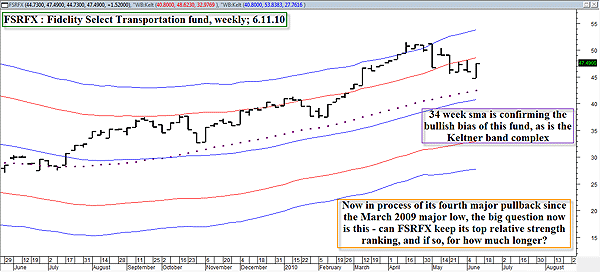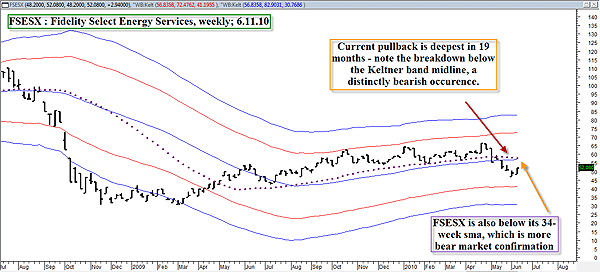
HOT TOPICS LIST
- MACD
- Fibonacci
- RSI
- Gann
- ADXR
- Stochastics
- Volume
- Triangles
- Futures
- Cycles
- Volatility
- ZIGZAG
- MESA
- Retracement
- Aroon
INDICATORS LIST
LIST OF TOPICS
PRINT THIS ARTICLE
by Donald W. Pendergast, Jr.
Not much has changed in the world of sector fund relative strength over the past few months; transportation stocks are still outperforming even as energy-related shares continue to languish.
Position: N/A
Donald W. Pendergast, Jr.
Donald W. Pendergast is a financial markets consultant who offers specialized services to stock brokers and high net worth individuals who seek a better bottom line for their portfolios.
PRINT THIS ARTICLE
MUTUAL FUNDS
Best Of Funds, Worst Of Funds
06/15/10 08:54:16 AMby Donald W. Pendergast, Jr.
Not much has changed in the world of sector fund relative strength over the past few months; transportation stocks are still outperforming even as energy-related shares continue to languish.
Position: N/A
| Most all of the Fidelity Select Sector funds have taken a tumble over the past two months, but if you place these near-term declines into a larger perspective, it's clear that the Fidelity Select Transportation (FSRFX) fund is still a good place for mutual fund timers to place a portion of their trading funds, especially compared to the still-struggling energy complex funds. Here's a quick look at the transportation and energy services sector funds, followed by a few practical tips for sector fund market timers. |

|
| FIGURE 1: FSRFX, WEEKLY. FSRFX retains its top relative strength ranking, but will the current swing higher manage to exceed April's high? |
| Graphic provided by: MetaStock. |
| |
| Nothing too complicated in Figure 1; FSRFX continues to display amazing strength, even as it rises out of its fourth major pullback since the major low of March 2009. The fact that the fund is also in the upper half of its Keltner band complex even as it also remains above its upsloping 34-week simple moving average (SMA) lends a decidedly bullish air to this weeky chart. For as long as the broad markets continue to rise, playing the stocks (from the long side) in the trucking, airline, and railroad industries might prove to be a wise strategy. Some stocks to consider doing further evaluation on: YRCW JBHT ABFS UAUA CAL DAL BNI UNP |

|
| FIGURE 2: FSESX, WEEKLY. FSESX still remains at the bottom of the 40-fund ranking hierarchy; the simultaneous break of the fund beneath both its 34-week SMA and the Keltner band midline is an especially bearish omen. |
| Graphic provided by: MetaStock. |
| |
| Now, a quick look at FSESX, the Select Energy Services fund, which is not a very healthy specimen at this point (Figure 2). Unlike the transportation fund, FSESX is below its 34-week SMA and has also descended into the lower half of its own Keltner band complex. The current pullback (a trend reversal, really) is the most severe since the massive bear move of 2008. Given that weak market sectors remain weak, those interested in playing the short side in stocks like these may stand an above-average chance of achieving short-term profits: HAL RIG SLB DO BHI |
| Now, a couple of ideas for those interested in trading and/or investing in sector mutual funds. First off, realize that these funds are long-only instruments and that there are usually penalties involved if positions are closed before a 31-day holding period is achieved. They usually have a minimim dollar allocation per fund as well. The big idea with sector fund trading/investing is to deploy your capital into the funds with the best weighted relative strength ranking score, holding the fund for as long as it continues to outperform the other funds (there are 40 sector funds at Fidelity) and/or the broad market in general. So even if you get hit with an occasional short-term trading penalty fee, over the long haul you can still make good money if you can come up with a system that can both identify and then hold strongly trending funds for months at a time. Here's a basic trading template/screening plan to help get you started in sector fund trading: 1. Broad market must be above its 12-week exponential moving average (EMA). 2. Rank all 40 Select Sector funds based on a combined weighted average of their three-, six-, and 12-month performance rankings. Some market timers weight the three-month period more heavily than the six- and 12-month performances, for example, while others believe that the six- and 12-month performance statistics are more important. 3. Once you've determined that the broad market is in bullish mode (per no. 1 above), pick the top four or five funds based on the weighted relative strength ranking score. As long as a top-ranked fund is over its 34-week SMA and the broad market (Standard & Poor's 500) is above its 12-week EMA, you might consider putting an equal amount of trading capital into each of the four or five funds that pass muster. 4. Hold each fund for as long as it remains in the top five in rank and for as long as it manages to make a weekly close above its 34-week SMA. Funds that fall out of favor are then replaced with new top-five ranked funds that are above their own 34-week SMAs. Admittedly, a method like this seems too simple to be workable in the real world, but my own testing tends to prove that such a method can and will make money over the long haul. If the broad market is weak (below its 12-week EMA), you either stay in the safety of cash, gradually closing out existing long positions as soon as they fall beneath their 34-week SMA. In true bear markets, you'll be entirely flat, able to nurture buying power for the next bull phase in the market. You may need to play with your ranking system to come up with something that works well to identify the strongest funds, so spend some time working on that. In addition, some may find the 34-week SMA to be a little wide as it does tend to allow a lot of profit to give back at times when major trend reversals appear. For that reason, you may want to experiment with shorter moving averages (a 25- to 32-week EMA hugs prices more closely while still allowing strong moves to run, so that could be one avenue to explore) that can help to retain more of your hard-won profits. Trading mutual funds with a relative strength system is based on a sound set of market dynamics, and since you can also fine-tune such a system to remain in cash during times of broad market weakness, it could be a near-perfect way for those with retirement funds to make steady profits during bullish market phases. |
Donald W. Pendergast is a financial markets consultant who offers specialized services to stock brokers and high net worth individuals who seek a better bottom line for their portfolios.
| Title: | Writer, market consultant |
| Company: | Linear Trading Systems LLC |
| Jacksonville, FL 32217 | |
| Phone # for sales: | 904-239-9564 |
| E-mail address: | lineartradingsys@gmail.com |
Traders' Resource Links | |
| Linear Trading Systems LLC has not added any product or service information to TRADERS' RESOURCE. | |
Click here for more information about our publications!
Comments

|

Request Information From Our Sponsors
- StockCharts.com, Inc.
- Candle Patterns
- Candlestick Charting Explained
- Intermarket Technical Analysis
- John Murphy on Chart Analysis
- John Murphy's Chart Pattern Recognition
- John Murphy's Market Message
- MurphyExplainsMarketAnalysis-Intermarket Analysis
- MurphyExplainsMarketAnalysis-Visual Analysis
- StockCharts.com
- Technical Analysis of the Financial Markets
- The Visual Investor
- VectorVest, Inc.
- Executive Premier Workshop
- One-Day Options Course
- OptionsPro
- Retirement Income Workshop
- Sure-Fire Trading Systems (VectorVest, Inc.)
- Trading as a Business Workshop
- VectorVest 7 EOD
- VectorVest 7 RealTime/IntraDay
- VectorVest AutoTester
- VectorVest Educational Services
- VectorVest OnLine
- VectorVest Options Analyzer
- VectorVest ProGraphics v6.0
- VectorVest ProTrader 7
- VectorVest RealTime Derby Tool
- VectorVest Simulator
- VectorVest Variator
- VectorVest Watchdog
